 The Aldwych Station Experience
The Aldwych Station Experience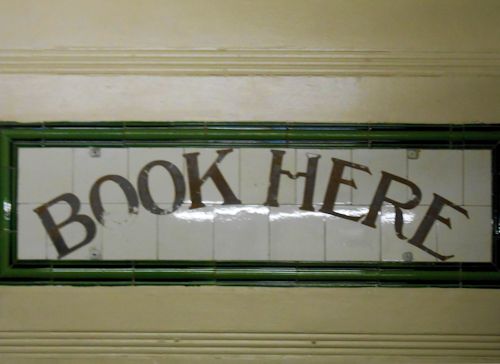
Following on from my first recent experience in the hidden underworld of Down Street Station, which was used by Churchill as a secret bunker during World War Two – this time I’m underground where the masses of ordinary people took wartime shelter. The Strand Station was built to the same basic Leslie Green designs as were many other stations including Down Street, Leicester Square, Covent Garden, Camden Town, Hampstead, Elephant and Castle and Oxford Circus to name but a few. Originally opened in 1907, as the Strand Station, before a change of name to “Aldwych” during May 1915, to avoid any confusion (the Northern Line at Charing Cross was also called “Strand” before being renamed Charing Cross). Both Surrey Street and the Strand entrances had “Piccadilly Tube” on their facades when the station first opened. Not long afterwards, these were changed to “Piccadilly RLY” as the Underground Electric Railways Company of London (UERL) disliked the word “Tube.” You could say that Aldwych has been a tube curiosity since opening. Fearing that the station would be little used, the economy was sought during construction. Only one set of stairs and passages to the platforms were completed and only about half the platform area (at the south end where the short trains would stop) had tiles. The remaining passages were left incomplete and never opened, all passengers using what would have been the exit passages to access platforms or lifts.
Our volunteer tour guides, Steve, Audrey and John were delighted to show us around, explaining that Aldwych Station is 110 feet deep and coincidently almost one-hundred and ten years old. The side of the station has a small underground stream which flows from the well at St Clements Danes, (underneath what is now Strand Passage) down to the river Thames. This area of the city before building began was mainly rundown slums or rookeries which were close to the plush theatres, along with the Strand and Covent Garden. Most of the slums were cleared and a new wide modern roadway was built from Holborn to the Aldwych, which was to become Kingsway. It was suggested in the late 1890’s a train line should be cut beneath the Kingsway to meet-up with the busy Kings Cross trains going to Holborn. The Piccadilly line was created by the merger of two separate Tube projects. They were linked at Holborn to create the Great Northern, Piccadilly and Brompton Railway (GNP&BR) which was opened between Hammersmith and Finsbury Park in 1906.
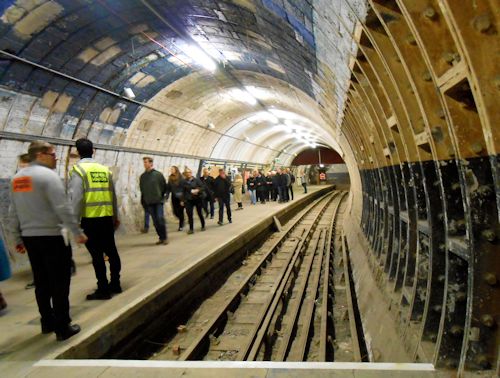
The Holborn – Strand line was to become self-contained with two platforms at Holborn instead of one as originally planned. A single trailing junction would link the branch to the eastbound main line just north of the station to facilitate stock movements. The second platform would be a shorter platform, which would allow two simultaneous services to run between Holborn and the Strand.
Finance was hard to come by for this project and eventually the scheme was taken over by an American sponsor, Charles Tyson Yerks, who had made a fortune building and electrifying urban rail and tram lines in Chicago. His business methods were dubious, but he was already heavily involved financing other underground works in London, Yerks it is said succeeded where others had failed, giving London a modern rapid transit system.
Although the branch always had two tunnels and twin platforms at either end, it was normally operated with a single two-car train as a shuttle service using the western tunnel only. The trains only ever run from Aldwych to Holborn, although there were plans originally to tunnel under the Thames to Waterloo, this was never instigated.
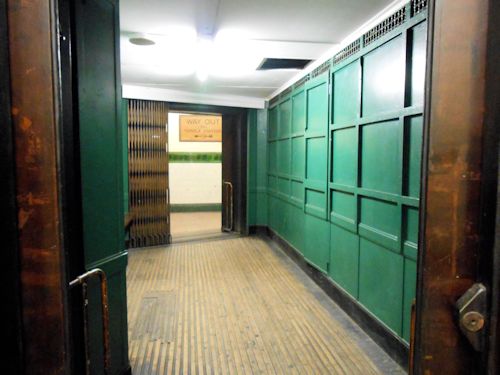
The Otis Lift the oldest set of lifts on the entire underground network
Probably the most historically important and unique feature in Aldwych Station is the original Otis lifts, they are the oldest set of lifts on the entire underground network. Three other lift shafts were built, just in case passenger number increased; they are 33 metres deep and were dug entirely by hand like all the rest of this station. That’s like the equivalent of digging seven stories underground!
War Stations and Marbles
This station was never very crowded, even in the rush hours. The eastern platform at Aldwych was not used at all for train services from about 1914. Soon afterwards, when German bombing raids on London began during the First World War, this disused platform was converted into an emergency store for 300 paintings from the National Gallery. Tube stations were not official civilian air-raid shelters, but thousands of people did take shelter at Aldwych when raids were heaviest in 1917. By the late 1930’s another war looked likely as Hitler’s Nazi regime adopted an aggressive foreign policy. By the time war broke out in 1939, tube sheltering was still officially discouraged, but working-class Londoners bombed out of their homes took matters into their own hands. They effectively invaded the tubes and forced a change in the Government policy. Aldwych was a good station for sheltering because it could be closed for service without affecting the rest of the underground network. On the 21st September 1940, the Tube service on the Aldwych branch was suspended and by 22nd October wardens from Westminster City Council managed the shelter. The late George Formby even gave a live B.B.C performance in front of an audience of hundreds sheltering there. The disused platform and tunnel were allocated for storage for both the V&A and British Museum. Both museums moved thousands of valuable items into storage, one of the most significant artefacts being the Elgin Marbles, which were so heavy a special hoist had to be installed – some of the hoist remnants and markings still remain to this day. The Elgin Marbles were returned to the British Museum in 1948 but were not put back on public display until 1962.
The End of the Line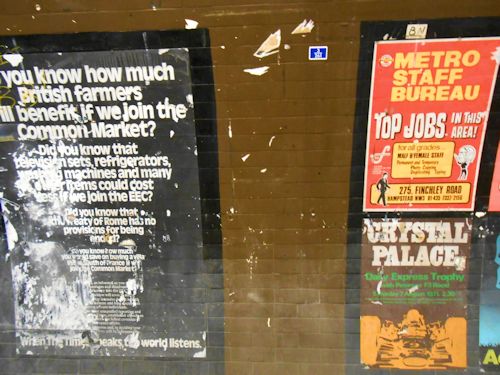
Note the ad on the left was promoting Britain's entry to the Common Market
One of the reasons why this station closed was because of all the wonderful historic features. The Otis lifts for example, by 1990 they had been in constant use for nearly ninety years and in need of desperate replacement, which would have cost about £3m and with a complete upgrade of the station would have cost about £4m more – £7m cost could not be justified with so few travellers (450 per weekday) using it. So in 1994 Aldwych closed to the public and although now closed for twenty-years or so it has found other uses. There is a fully working track which TfL (Transport for London) have been able to use to test new materials and new equipment. In 2012 it was part of operation “Forward Defence” which was the largest simulated terrorist attack in London, designed to train TfL staff and also emergency services in what to do if there was a terrorist attack during the Olympics.
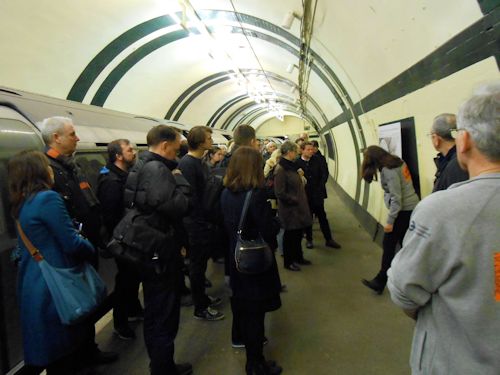
Because of its unique design, it has also been used for filming; Madness, The Kinks and also Prodigy have all shot music videos here. Films like; Sliding Doors, Atonement, Constant Gardener, Die Another Day, V for Vendetta, Creep, Superman 4, 28 Weeks Later, The Deep Blue Sea, The Imitation Game – the list is never-ending. Also, some recent television programmes were filmed here like; Sherlock Holmes and Mr Selfridge.
The last train to carrying the general public left the Aldwych on the evening of 30th September 1994, almost 87 years since first opening.
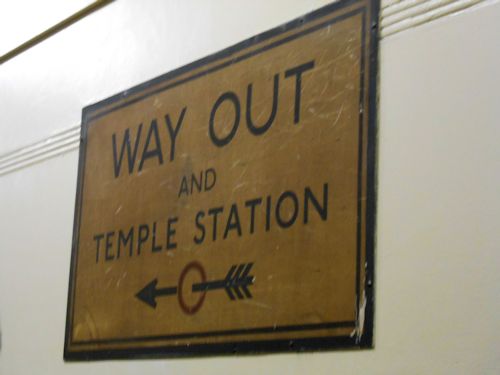
London Time

Follow Us
The contents of this website are the property of knowledgeoflondon.com and therefore must not be reproduced without permission. Every effort is made to ensure the details contained on this website are correct, however, we cannot accept responsibility for errors and omissions.
© Copyright 2004 -
Contact Us | Advertise